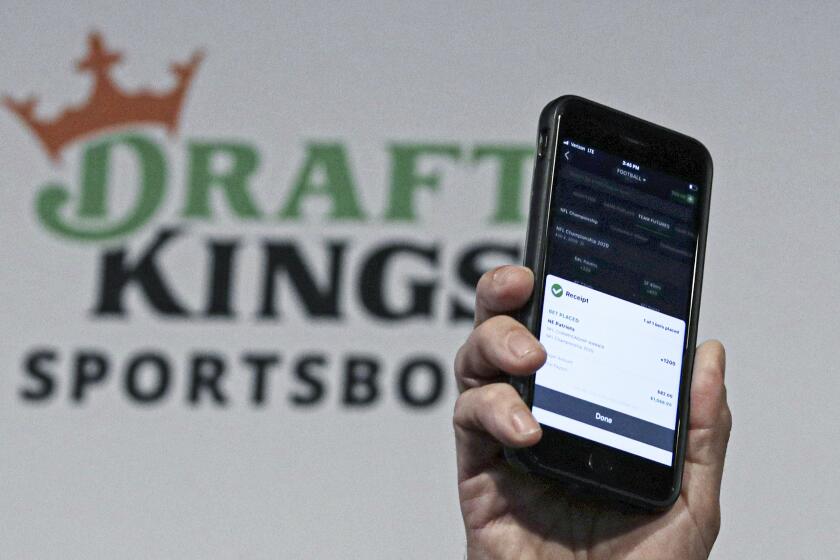Guessing Game Over Teledyne Intensifies
Teledyne Inc. has long been Wall Streetâs idea of a good mystery novel. Run by two publicity-shy septuagenarians, the $4.6-billion (sales) conglomerate seems to be a breakup waiting to happen.
But when? And what prices would the various pieces bring? Those questions have fascinated some Teledyne investors--and annoyed others--for years. Now, Chairman Henry Singleton, 73, and Chief Executive George Roberts, 71, are rethinking some long-held Teledyne strategies, and in the process they are rejuvenating the guessing game over the Los Angeles companyâs future.
One of the biggest strategy shifts takes place Friday, when Teledyne stock will split 5 for 1. Then, sometime in mid-April, Teledyne will spin off to shareholders its insurance units, leaving the parent company with its diverse manufacturing operations.
The stock split, in particular, marks a major change in Singletonâs handling of Teledyne. Most companies routinely split their stocks as the price rises over time, to keep the shares at a reasonable level. Splits keep a stock within reach of individual investors and also multiply the number of shares outstanding, making it easier to trade the stock--liquidity, as Wall Street likes to call it.
Teledyne, however, hasnât split since 1981. Instead, Singleton has allowed the price to rise--to the point where, at $330.50 now, it is the second highest priced common stock on the New York Stock Exchange, after Berkshire Hathaway.
With the split, Teledyne will trade for about $66 a share, and the number of shares outstanding will jump to 55 million from 11 million. To some big investors, the split raises the likelihood that the aging Singleton and Roberts, who own 13% and 0.9% of Teledyne, respectively, have plans for their shares--though neither ever comments on such talk.
âItâs possible that they want to get their positions more liquid so they can cash out,â said Abbott Keller, vice president with Concord Capital Management in San Mateo, Calif. Concord, a $2-billion money manager, owns about 88,000 Teledyne shares.
The idea of Singleton and Roberts cashing out raises a number of possibilities, each of which has its own special intrigue for Teledyne fans. If they sell significant amounts of stock and bow out, Teledyne could conceivably become the target of a hostile takeover. If they decide to sell their stakes whole, Teledyne could be sold in one piece to a friendly buyer. If they sell gradually while turning the company over to a new management team, the new chief executive might on his own decide that Teledyne is worth more broken up than as a single entity.
Indeed, the question of âWhatâs it worth?â really is the only question on most investorsâ minds when the topic is Teledyne. To many money managers, the company is a confusing jumble of businesses, including insurance, aircraft engines, semiconductors, specialty metals, machine tools, swimming pool heaters and Water Pik appliances.
The stock was a stellar performer for much of the 1980s, and it rose solely on the basis of the increasing assets that master builder Singleton was accumulating under the Teledyne umbrella (the stock paid no dividends until 1987). But in recent years, the stock has stagnated as some investors have appeared to lose interest in the Teledyne mystique.
Thatâs why the second major upcoming change at Teledyne will be closely watched: By spinning off the insurance unit, Teledyne--and its investors, including Singleton--will see if Wall Street treats two separate Teledyne entities better than it treated them together.
The insurance spinoff, to be named Unitrin, will include Teledyneâs United Insurance and Trinity Universal Insurance arms, which are in the businesses of life, health and property insurance. They account for about 20% of Teledyneâs sales. Shareholders will get one share of Unitrin for each share of Teledyne held as of March 20, in a tax-free deal.
Will the two pieces trade separately for more than Teledyne alone trades for now? David Moore, analyst at Donaldson, Lufkin & Jenrette in New York, is convinced that will be the case. While Teledyne as one company will trade for about $66 a share post-split, Moore sees Unitrin trading for $40 to $44 and the surviving Teledyne trading for $34 to $36.
So at a minimum, $66 invested now becomes $74--though not necessarily overnight, he said. Whatâs more, in an unusual display of generosity, Teledyne will have Unitrin pay the same annual cash dividend that Teledyne pays (80 cents a share, post-split). So Teledyne shareholders will effectively see their dividend doubled if they keep both stocks.
Moore and other analysts say Unitrin has excellent growth prospects, because it has far more capital than it needs. Unitrin would have earned $1.92 a share last year on its own; its book value is about $33 a share.
Another kicker is that Unitrin will take with it most of Teledyneâs 25% stake in Litton Industries--an investment that is likely to be sold eventually at a huge profit.
Meanwhile, the prospects of the remaining Teledyne manufacturing businesses--and the ânewâ Teledyne stock--are less certain. After spinning off the insurance unit, Moore notes that one-third of Teledyneâs earnings will be derived from aerospace. In an era of defense cutbacks, the stock is unlikely to thrill many investors for its fundamentals.
That may be why Teledyne stock hasnât reacted favorably to the upcoming split and the Unitrin spinoff. From $343.25 at year-end, the stock has sunk 4% to date.
Still, Teledyneâs fans say the patient investor is bound to make good money in the stock. Many continue to believe that the manufacturing businesses eventually will be sold off individually or as a group. Most of the manufacturing companies âgenerate tons of cash,â said analyst Sidney Heller at Shearson Lehman Hutton in New York. So even in a sour environment for defense businesses, many Teledyne companies are solid enough to be attractive targets.
Analyst Lawrence M. Harris at Bateman Eichler, Hill Richards in Los Angeles notes that some of the manufacturing units could easily be taken private in leveraged buyouts if management were willing to entertain offers for them.
Overall, âthereâs value in Teledyne stock long-term,â Heller said. âItâs just a question of how long.â
But even the stockâs biggest fans admit thereâs still a big risk in trying to forecast what Singleton and Roberts might or might not do with Teledyne.
Wall Street has been trying to read Singletonâs mind for 20 years, Moore said, âand no one has been right so far.â
TELEDYNEâS LONG RUN: After soaring for much of the 1980s, Teledyne stock has stagnated since 1987.
TELEDYNEâS PLAN
Split the stock, now $330.50 a share, 5-for-1 on Friday. Result: The stock will trade at about $66 a share, within reach of more potential buyers.
Spin off the companyâs insurance arm to shareholders by mid-April. For each Teledyne share post-split, shareholders will get one share in the insurance unit.
Effectively double the dividend. The insurance unit will pay the same annual dividend that the parent company pays (80 cents a share post-split). So shareholders who keep both stocks will see their dividend doubled.
Los Angeles Times
More to Read
Inside the business of entertainment
The Wide Shot brings you news, analysis and insights on everything from streaming wars to production â and what it all means for the future.
You may occasionally receive promotional content from the Los Angeles Times.










